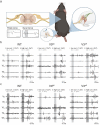This is a preprint.
Distinct roles of spinal commissural interneurons in transmission of contralateral sensory information
- PMID: 36824871
- PMCID: PMC9949098
- DOI: 10.1101/2023.02.16.528842
Distinct roles of spinal commissural interneurons in transmission of contralateral sensory information
Update in
-
Distinct roles of spinal commissural interneurons in transmission of contralateral sensory information.Curr Biol. 2023 Aug 21;33(16):3452-3464.e4. doi: 10.1016/j.cub.2023.07.014. Epub 2023 Aug 1. Curr Biol. 2023. PMID: 37531957 Free PMC article.
Abstract
Crossed reflexes (CR) are mediated by commissural pathways transmitting sensory information to the contralateral side of the body, but the underlying network is not fully understood. Commissural pathways coordinating the activities of spinal locomotor circuits during locomotion have been characterized in mice, but their relationship to CR is unknown. We show the involvement of two genetically distinct groups of commissural interneurons (CINs) described in mice, V0 and V3 CINs, in the CR pathways. Our data suggest that the exclusively excitatory V3 CINs are directly involved in the excitatory CR, and show that they are essential for the inhibitory CR. In contrast, the V0 CINs, a population that includes excitatory and inhibitory CINs, are not directly involved in excitatory or inhibitory CRs but down-regulate the inhibitory CR. Our data provide insights into the spinal circuitry underlying CR in mice, describing the roles of V0 and V3 CINs in CR.
Figures







References
-
- Sherrington C. S. On Reciprocal Innervation of Antagonistic Msucles.-Eighth Note. Proc. R. Soc. B 76, 269–297 (1905).
Publication types
Grants and funding
LinkOut - more resources
Full Text Sources
